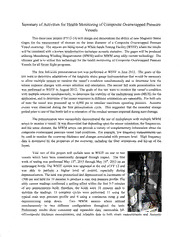
NASA Technical Reports Server (NTRS) 20130014495: Summary of Activities for Health Monitoring of Composite Overwrapped Pressure Vessels PDF
Preview NASA Technical Reports Server (NTRS) 20130014495: Summary of Activities for Health Monitoring of Composite Overwrapped Pressure Vessels
Summary of Activities for Health Monitoring of Composite Overwrapped Pressure Vessels This three-year project (FY12-14) will design and demonstrate the ability of new Magnetic Stress Gages for the measurement of stresses on the inner diameter of a Composite Overwrapped Pressure Vessel overwrap. The sensors are being tested at White Sands Testing Facility (WSTF) where the results will be correlated with a known nondestructive technique acoustic emission. The gages will be produced utilizing Meandering Winding Magnetometer (MWM) and/or MWM array eddy current technology. The ultimate goal is to utilize this technology for the health monitoring of Composite Overwrapped Pressure Vessels for all future flight programs. The first full-scale pressurization test was performed at WSTF in June 2012. The goals of this test were to determine adaptations of the magnetic stress gauge instrumentation that would be necessary to allow multiple sensors to monitor the vessel's condition simultaneously and to determine how the sensor response changes with sensor selection and orientation. The second full scale pressurization test was performed at WSTF in August 2012. The goals of this test were to monitor the vessel's condition with multiple sensors simultaneously, to determine the viability of the multiplexing units (MUX) for the application, and to determine if the sensor responses in different orientations are repeatable. For both sets of tests the vessel was pressured up to 6,000 psi to simulate maximum operating pressure. Acoustic events were observed during the first pressurization cycle. This suggested that the extended storage period prior to use of this bottle led to a relaxation of the residual stresses imparted during auto-frettage. The pressurization tests successfully demonstrated the use of multiplexers with multiple MWM arrays to monitor a vessel. It was discovered that depending upon the sensor orientation, the frequencies, and the sense element, the MWM arrays can provide a variety of complementary information about the composite overwrapped pressure vessel load conditions. For example, low frequency measurements can be used to monitor the overwrap thickness and changes associated with pressure level. High frequency data is dominated by the properties of the overwrap, including the fiber orientations and lay-up of the layers. Year two of this project will include tests at WSTF on one or two vessels which have been intentionally damaged through impact. The first week of testing was performed May 131 2013 through May 161 2013 on an h, \ undamaged bottle. The WSTF system was upgraded at the end of FY 12 and was able to perform a higher level of control, especially during depressurization. The tank was pressurized and depressurized in increments of 1500 psi and held for 10 minutes to produce a stair step pressure profile. The eddy current readings confumed a settling effect within the first 5-7 minutes of any pressurization hold; therefore, the holds were 10 minutes each to stabilize the readings. 15 complete cycles were performed; 11 using the typical stair step pressure profile and 4 using a continuous ramp p and depressurizing ramp down. Two MWM sensors where utilized simultaneously in two different configurations throughout the tests. Preliminary results show consistent and repeatable data, measurable lift off/composite thickness measurements, and relatable data to both strain measurements and Acoustic Emissions (AE). The second week of testing, roughly slated for August 2013, will be performed on a damaged-by-impact bottle. The impact will reduce the strength of the bottle by approximately 20%. Readings will be taken utilizing upgraded sensors that do not require a MUX.
